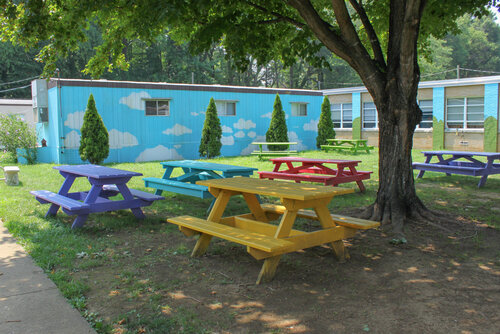Outdoor Learning Spaces
Article | 01.12.20212020 has left a mark on education that will likely be felt for years to come. From a shutdown to schools in the spring, to a rethinking of our educational environments as students returned to class in the fall, whether that be in person, hybrid or remote, learning spaces are being transformed. While planning to return to school with social distancing in place schools were forced to determine how to utilize existing classrooms, media centers, gyms and lunchrooms and outdoor spaces to meet the needs of their students. Even as vaccines are being administered, the uncertainty of social distancing guidelines at school remains.
Outdoor classrooms are a great way to provide space and flexibility for schools. With current guidelines calling for 6’ of space between students or fewer than 11 persons in a room, to increased fresh air and ventilation, outdoor spaces offer a wide range of flexibility. Examples of outdoor classrooms range from logs arranged under a tree, to tents erected in a playground or parking lot, to gazebos and other existing structures. If an outdoor classroom needs to be utilized for an entire day appropriate infrastructure would need to be developed, such as technology, desks, etc. But if outdoor spaces were used for breakout spaces or specific learning opportunities the required infrastructure would be much less.
With many schools rearranging their facilities to meet the current needs, resources are being developed. The National COVID-19 Outdoor Learning Initiative was cofounded in May 2020 with 4 organizations and now has expanded to include more than 15 other partner organizations to provide resources for outdoor learning environments. This organization has posted numerous resources and case studies to aid in the creation of outdoor learning environments.
While outdoor learning environments may seem out of the norm, there is a rich history of examples of outdoor learning spaces. Outdoor learning spaces also have many benefits. Studies have shown that access to nature and greenery helps to improve mood, reduce stress, improve ability to concentrate and increase the overall sense of well-being. The Child Mind Institute has found that benefits of time outdoors include confidence, creativity and imagination, responsibility, more physical movement and less stress and fatigue. The Center for Parenting Education adds that time outdoors leads to more friendships, ADHD relief and better performance in school. Outdoor spaces are a great place to explore science and nature which fits well into STEM curriculums. Recent classroom trends include flexible furniture and brain breaks. Why not utilize our outdoor spaces as assets to enhance learning?
So as we begin to look towards spring, let’s not only think about how we can create outdoor learning spaces that help to create social distance in the short term, but let’s create outdoor spaces that are flexible and can be utilized as tool in our education toolbelt moving forward.
Pictured below is Ben's daughter Abigail at the Butterfly Garden created at Brown Elementary School in St. Joseph, Michigan.

Expertise
